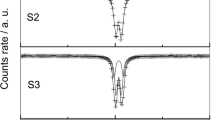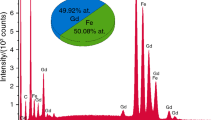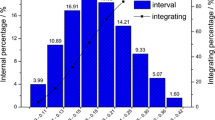Abstract
The hydrated oxides which are formed by the addition of ammonium bi-carbonate to a solution of Zn(NO3)2 and Fe(NO3)3, and drying the precipitates at 110° are zinc hydroxy carbonate(I) and iron(III) oxide gel(II), respectively. A new, derived derivative thermogravimetric curve along with conventional DTA and DTG methods have been used to study the reaction between (I) and (II) in two components system.
A mixture of (I) and (II) subjected to grinding yields about 16% zinc ferrite ‘precursor’. In a sample prepared by coprecipitation from the mixed nitrate solution and drying at 110°, nearly 70% ‘precursor’ is formed. The formation of zinc ferrite spinel reported to take place at low temperature in such cases appears to be related with the formation of the ‘precursor’, and reactivity and phase transformation temperature in Fe2O3.
Résumé
Les oxydes hydratés formés lors de l'addition du bicarbonate d'ammonium à une solution de Zn(NO3)2 et de Fe(NO3)2 suivie du séchage du précipité à 110°, sont l'hydroxy-carbonate de zinc(I) et le gel de l'oxyde de fer(III) (II). On a utilisé une nouvelle technique de thermogravimétrie en dérivation, ainsi que les méthodes d'ATD et TGD conventionnelles, pour étudier la réaction entre (I) et (II) dans le système à deux composants.
Un mélange de (I) et de (II), soumis au broyage, donne environ 16 p.c. de ferrite de zinc «précurseur», tandis qu'un échantillon préparé par coprécipitation à partir de la solution des nitrates mixtes et séchage à 110°, en donne environ 70 p.c.
La formation du spinelle de ferrite de zinc décrite comme ayant lieu, dans des cas similaires, à des températures faibles, paraît être en rapport avec la formation du «précurseur» ainsi qu'avec la réactivité et la température de la transformation de phase de Fe2O3.
Zusammenfassung
Die durch Zugabe von Ammoniumbicarbonat zu einer Lösung von Zn(NO3)2 und Fe(NO3)3 und Trocknung des Niederschlags bei 110° gebildeten hydratisierten Oxide sind Zinkhydroxycarbonat (I) bzw. Eisen(III)oxidgel (II). Eine neue derivierte derivative thermogravimetrische Kurve wurde gemeinsam mit den konventionellen DTA und DTG Methoden zum Studium der Reaktion zwischen (I) und (II) in Zweikomponentensystemen eingesetzt.
Das Gemisch von (I) und (II) ergibt beim Mahlen etwa 16% Zinkferrit »Prekursor«. In einer durch Mitfällung der gemischten Nitrate und Trocknung bei 110° erhaltenen Probe wurde fast 70 % »Prekursor« gebildet. Die Bildung von Zinkferritspinell, über dessen Entstehung in solchen Fällen bei niedrigen Temperaturen berichtet wird, scheint mit der Bildung des »Prekursors« verbunden zu sein, sowie mit der Reaktivität und der Phasenübergangstemperatur in Fe2O3.
Резюме
При добавлении бикар боната аммония к раст вору Zn(NO3)2 и Fe(NO3)3, образуются гидроокиси, которые п осле высушивания при 110°, представляют собой, с оответственно, основной карбонат ци кла (I) и гель окиси трех валентного железа (II). Новая выведе нная производная термогр авиметрической крив ой, наряду с обычными методами ДТ А и ДТГ, была использова на для изучения реакц ии между I и II в двухкомпонентных с истемах. Смесь I и II, подверженна я измельчению, содерж ит около 16% вещества, предшеству ющего образованию феррита цинка. В образце, получ енном соосаждением смешан ных растворов нитратов и высушенном при 110°, почт и 70% образуется вещества, предшествующего образованию феррита цинка. Имеет место обр азование цинк ферритовой шпин ели при низкой температу ре и это может быть свя зано с образованием «предш ественника» феррита цинка, реакци онной способностью и температурой фазово го превращения в Fe2O3.
Similar content being viewed by others
References
C. J. Dean andM. P. Colling, Chem. Abstr., 76 (1972) 50631 w.
J. Beretka andM. J. Ridge, Nature, 216 (1967) 473.
I.Porubszky, G.Békásy, 3rd. Analytical Conference, 24–29 August, 1970, Budapest.
D. J. M.Bevan, J. P.Shelton and J. S.Anderson, J. Chem. Soc., (1948) 1729.
J. Beretka andA. J. Marriage, Austral. J. Appl. Sci., 15 (1964) 321.
D. W. Hopkins, J. Electrochem. Soc., 96 (1949) 195.
G. A. Adadurov, G. V., Novikov, N. S. Ovanesyan, V. A. Trukhtanov andV. M. Shekhtman, Fiz. Tverd. Tela, 11 (1969) 1988.
V. P. Chalyi andE. N. Lukachina, Izv. Akad. Nank. SSR, Neorg. Mater, 3 (1967) 1447.
B. R. Arora, R. K. Banerjee andB. N. Singh, J. Thermal Anal., 13 (1978) 499.
A. I. Vogel, Text Book of Quantitative Inorganic Analysis. Longmans Green, London 1964.
R. C. Mackenzie, Differential Thermal Analysis, Vol. 1, Academic Press. London. 1970.
K. M. Towe andW. F. Bradley, J. Colloid Interface Sci, 24 (1967) 384.
Author information
Authors and Affiliations
Rights and permissions
About this article
Cite this article
Singh, B.N., Banerjee, R.K. & Arora, B.R. Thermoanalytical study of the solid state reaction between hydrated ZnO and Fe2O3 . Journal of Thermal Analysis 18, 5–13 (1980). https://doi.org/10.1007/BF01909448
Received:
Revised:
Issue Date:
DOI: https://doi.org/10.1007/BF01909448




